Sun Catchers: The Future of Solar Panel Technology
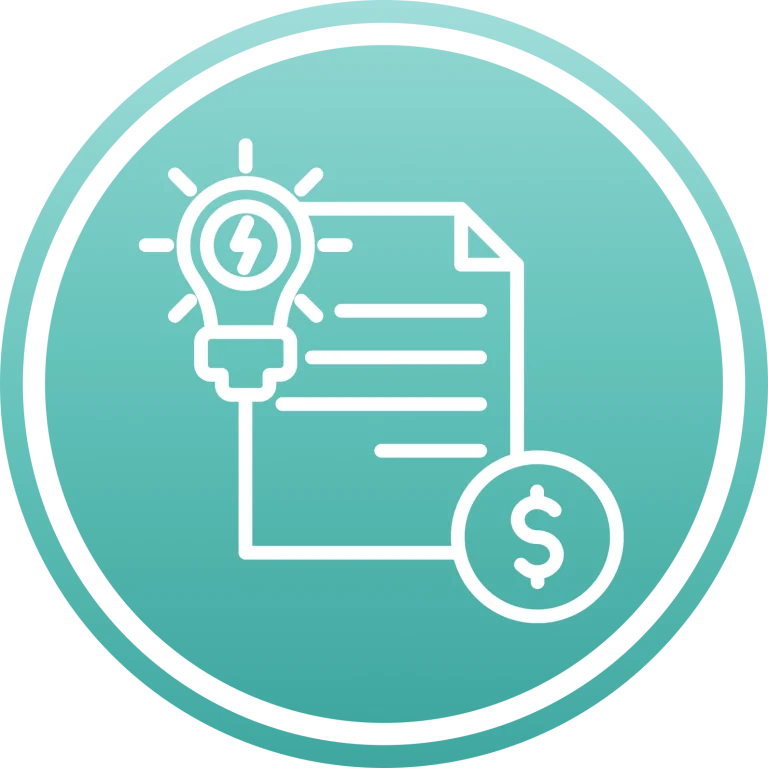
We have some important news to share with you regarding Eskom’s proposed electricity price increase and Solar Panels. As you may have heard, Eskom has announced its intention to raise electricity prices by a staggering 36.1% in 2025. While this increase has not yet been finalised, it’s a strong indication that power prices will continue to rise, placing even more pressure on your electricity bill. Households and businesses are searching for alternatives to power their homes and operations without breaking the bank. The answer is clear—solar panels. Investing in solar energy is no longer just an eco-friendly option; it’s now the smartest financial decision you can make.
What Are Solar Panels?
Solar panels are devices that convert sunlight into electricity using photovoltaic (PV) cells. These cells are made of semiconductor materials, such as silicon, which generate an electric current when exposed to sunlight. This energy is then harnessed and converted into usable electricity for homes and businesses.
Solar panels come in different types, including monocrystalline, polycrystalline, and thin film, each with varying efficiency levels and price points. Monocrystalline panels are the most efficient and durable, while polycrystalline panels offer a more budget-friendly alternative. Thin-film panels, though less efficient, are lightweight and flexible, making them suitable for specific applications
Understanding Solar Energy: How Do Solar Panels Work?
Solar energy is harnessed from the sun’s rays using photovoltaic solar panels. These panels convert sunlight into direct current electricity, which is then converted into alternating current (AC) electricity using an inverter. This AC power runs your household appliances, lights, and devices. Depending on your system setup, excess energy can be stored in batteries or fed back into the grid.
The process is seamless, and the benefits are undeniable. With solar panels, you generate your power, reducing reliance on Eskom and insulating yourself from unpredictable power cuts and tariff hikes. Whether you install an off-grid or hybrid solar system, you take control of your electricity supply, ensuring a stable and reliable power source. Solar energy also reduces your carbon footprint, contributing to a cleaner and more sustainable environment.
Why Solar Panels Are the Best Choice Now:
1. Eskom’s Proposed Price Hike Makes Solar the Smarter Investment:
With Eskom’s proposed electricity price increase of 36.1% in 2025, electricity bills will skyrocket, putting immense financial strain on households and businesses. The more you consume from the grid, the higher your costs will climb. But with solar panels, you significantly reduce your reliance on Eskom, making your energy expenses more predictable and manageable.
Investing in solar protects yourself from future price hikes while enjoying sustainable energy for decades to come. Instead of throwing money at escalating electricity bills, why not channel those funds into a solar panel system that pays for itself in just a few years
2. Load-shedding and Power Stability
South Africa’s ongoing load-shedding crisis continues to disrupt daily life. With rolling blackouts affecting businesses, home offices, and essential services, the need for a reliable power source has never been greater. Solar panels, paired with battery storage, ensure that you stay powered up when Eskom fails. No more interruptions—just seamless, uninterrupted energy. Solar power offers a sustainable and eco-friendly solution, reducing dependence on the national grid and alleviating pressure on the country’s overburdened infrastructure.
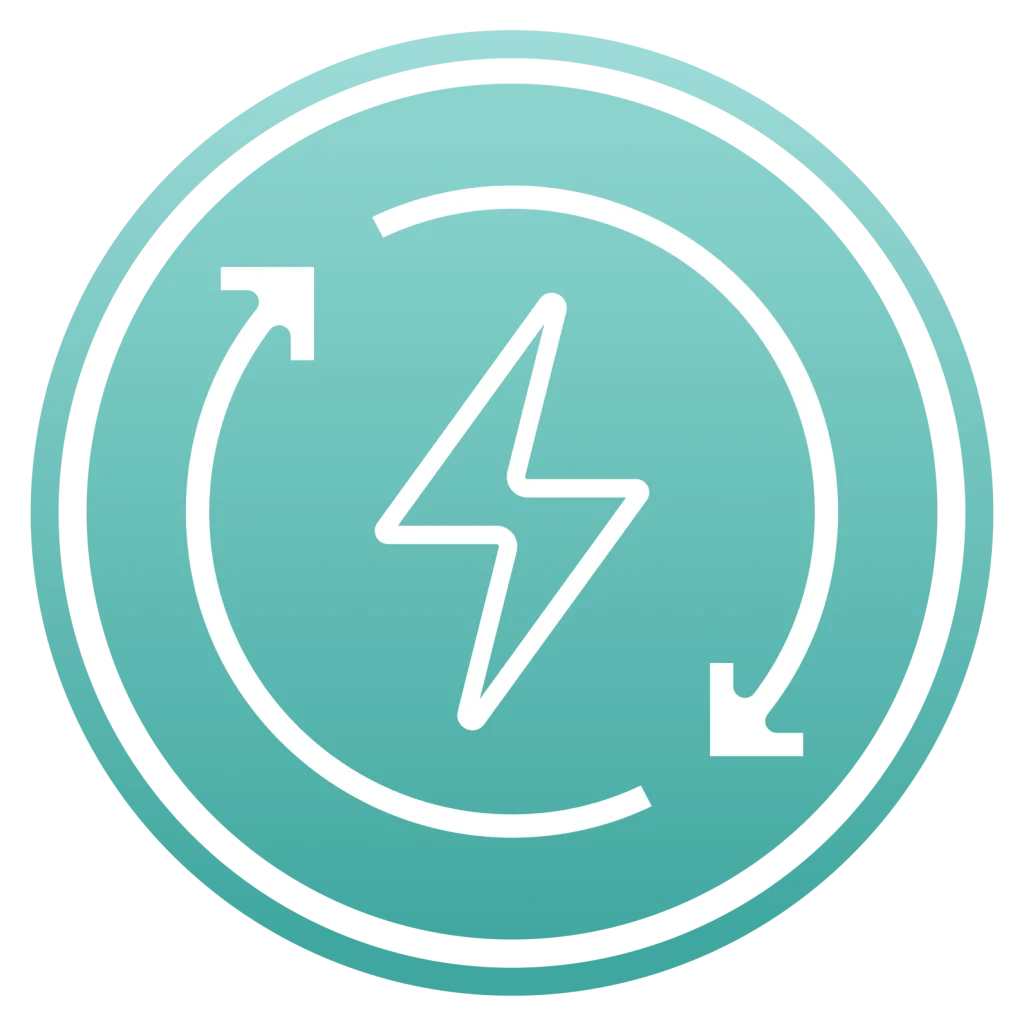
3. Environmental Benefits:
Beyond the financial advantages, solar power is an environmentally responsible choice. Traditional electricity generation relies heavily on coal, which releases harmful carbon emissions into the atmosphere. By switching to solar panels, you contribute to a cleaner, greener planet for future generations. Solar energy is renewable, meaning it doesn’t deplete natural resources like fossil fuels, ensuring a sustainable energy future. Unlike coal, solar power generation does not release any pollutants, making it a cleaner option for the environment. Solar panels help reduce air and water pollution, as they require no water for cooling, unlike conventional power plants. Additionally, the manufacturing process of solar panels is becoming increasingly efficient and environmentally friendly, with more companies focusing on sustainable production methods.
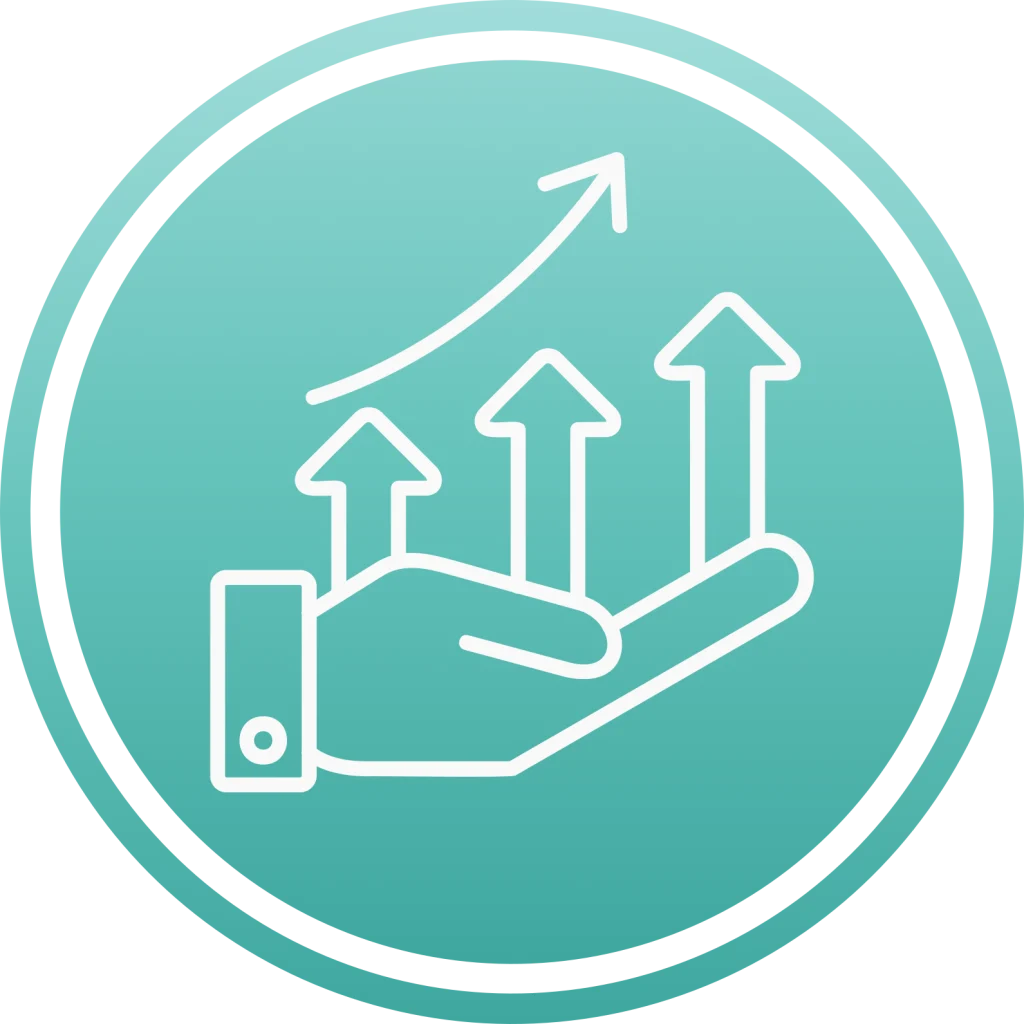
4. Property Value Boost:
A home or business equipped with solar panels is a valuable asset. Studies have shown that properties with solar installations tend to have higher resale values and attract buyers who are looking for energy-efficient solutions. If you’re thinking about long-term financial gains, solar panels are a wise investment that enhances your property’s appeal and marketability. Many potential buyers now prioritize energy efficiency and sustainability, making solar-powered homes more desirable. Properties with solar panels also stand out in competitive real estate markets, where eco-friendly features can set your listing apart.
Inverters and Batteries: Maximizing Your Solar Power System
What Is an Inverter?
An inverter is a crucial component of a solar power system. It converts the direct current (DC) electricity generated by solar panels into alternating current (AC) electricity, which is what powers your home. Without an inverter, the electricity produced by your solar panels would not be usable by most household appliances, which operate on AC power. Inverters also regulate the flow of electricity, ensuring that power is sent to your home safely and efficiently.
There are three main types of inverters:
String Inverters:
These are cost-effective and work well for large solar panel systems. They connect multiple solar panels in a series, with one inverter serving the entire system. String inverters are generally easier to install and maintain due to their centralized setup. However, their performance can be affected if one panel is shaded or underperforms, as the entire string’s output can be reduced.
Microinverters:
Installed on each panel, they optimize energy production and are more efficient in areas with shading. Since each panel operates independently, shading on one panel has little to no impact on the others. Microinverters also improve overall system efficiency and allow for more precise monitoring of individual panel performance. However, they tend to be more expensive and require more maintenance than string inverters.
Hybrid Inverters:
These allow seamless integration with battery storage, making them ideal for energy backup solutions. Hybrid inverters can manage both solar power generation and battery storage simultaneously, providing a more flexible and efficient energy management system. They are particularly useful for off-grid systems or for homeowners who want to store excess solar energy for use during the night or power outages. Additionally, hybrid inverters enable load management, directing energy where it’s needed most.
The Role of Batteries in a Solar Power System:
Solar batteries store excess electricity generated by your solar panels during the day for use at night or during load shedding. Popular battery types include:
Lead-Acid Batteries:
More affordable but requires regular maintenance. They have a shorter lifespan compared to other options and can be less efficient in terms of energy storage. Regular maintenance is needed to check the water levels and ensure the terminals are clean. They are often used in smaller or off-grid systems due to their affordability.
Lithium-Ion Batteries:
Longer lifespan, higher efficiency, and lower maintenance costs. They are lightweight and compact, making them suitable for a wide range of installations. These batteries charge faster and have a higher depth of discharge, meaning more usable capacity. Although they are more expensive up front, their long-term benefits and lower maintenance costs often make them a more economical choice in the long run.
Legacy Solar’s Summer Specials: The Best Time to Invest
Legacy Solar is making the transition easier by offering exclusive Summer Specials on solar panel installations, inverters, and battery storage systems. Whether you’re looking to install a full off-grid system or a hybrid solution, there’s a package that fits your needs and budget.
These summer deals are designed to make solar energy accessible to more homeowners and businesses, allowing you to take advantage of premium-quality systems at discounted prices. With the cost of electricity on the rise, now is the time to make the switch and future-proof your energy needs. Our summer specials also include limited-time financing options, enabling you to enjoy the benefits of solar energy with manageable payment plans. Don’t miss out on this golden opportunity to start saving while securing your energy independence.
What’s Included in the Summer Specials?
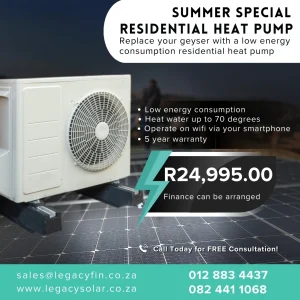
- Discount on Residential Heat Pumps

- Discount on a 5KW Luxpower Solar System
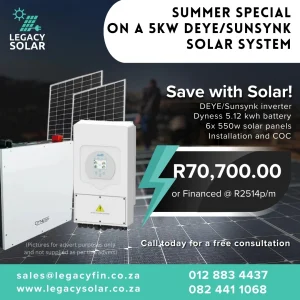
- Discount on a 5 KW Deye/Sunsynk Solar System
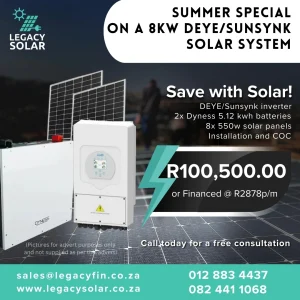
- Discount on a 8KW Deye/Sunsynk Solar System
The Time to Switch to Solar is Now:
With Eskom’s proposed electricity increase of 36.1% in 2025, the cost of doing nothing is simply too high. Investing in solar panels now means taking control of your energy costs, avoiding the burden of skyrocketing bills, and ensuring uninterrupted power. With Legacy Solar’s summer specials, making the switch is more affordable than ever.
Don’t wait until it’s too late—embrace solar energy today and experience the freedom of energy independence.
Contact Legacy Solar now to take advantage of our summer promotions and start your journey towards a brighter, cost-effective, and sustainable future!

